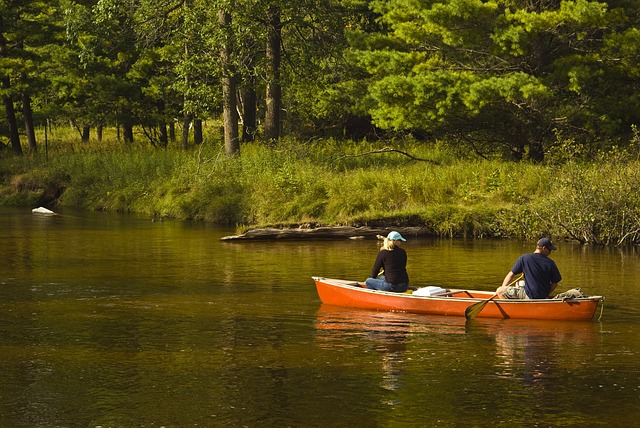You are probably curious to know about the different parts of a canoe if you’re new to canoeing and want to get started with this popular outdoor recreational activity. After all, knowing what each part of is called will allow you to communicate. Understanding each part’s purpose will also help you use your equipment appropriately. In this article I answer the common question What are the parts of a canoe? After I identify the name and function of each component, I’ll provide some personal tips and information that will help you if you ever choose to buy your own canoe.
List of the Major Parts of a Canoe
Here is a short list of the major parts of a canoe. Not every canoe will have each of these components.

In general, if you’re familiar with these names and their functions, then you’ll be able to speak about canoes like you know what you’re talking about.
Name of Major Canoe Parts
The hull: The hull is the bottom of the canoe and is the part that is in the water as you paddle.
The deck plate: The deck plate is the part that protects the top of the craft’s material. It can also be used as a handle. Today, many canoes also include a separate handle. This is usually made part of the deck plate. You can use the handle to carry the canoe to the water.
Gunwale: The gunwale occupies the length of the boat, going from the stern to the bow. It offers protection to the materials that make up the canoe. The gunwale can be comprised of wood, vinyl, or aluminum materials. The gunwale can be utilized to mount elements such as yolks, thwarts, and seats.
Seats: The canoe can have a variety of different kinds of seats options available. These include webbing seats, which have a wood frame, as well as seats with nylon webbing. Cane seats have a wood frame. If you go with molded plastic seats, you will find they sometimes have comfortable features such as backrests. And if you decide to upgrade the seats that come with your boat (or add a third seat in the middle of the boat) it’s easy to purchase a different style canoe seat or a canoe seat backrest (like this one on Amazon) and attach it yourself.

Thwarts: Thwarts are mounted to the canoe’s gunnels. They give extra structural support for the vessel to help it maintain its shape. There are a number of different varieties of thwarts, including standard straight thwarts. There will also be a center portage yoke. You can use this to transport the boat by yourself.
Keel: The keel is a protruding blade. It is small in size and stretches down the center of the bottom of the canoe. The main purpose of the keel is protection of the hull from damage, such as that caused by scrapes, punctures, and scratches. Keels are supposed to be replaced after a while. The keel also plays a part in keeping the canoe traveling straight while paddling.
What are the Front and Back of a Canoe Called?
Bow: The bow is the canoe’s front-most part. When the canoe touches oncoming water, the bow is the first part to make contact. This is why the shape of the bow is very important in determining how well it will cut through water. The bow should feature points at which you can anchor the boat, hang it during storage, attach it to a dock, or tie it down so that it can be securely transported atop your vehicle.

Stern: The stern is the canoe’s rear-most part. To help it move smoothly through the water, the stern must be designed in a certain shape. Like the bow, the stern should have points at which you can anchor the boat, hang it when storing it, attach it to a dock, and tie it down so that you can securely transport it atop your vehicle.
The bow seat: The bow seat is easily identified. The bow seat in a canoe is the seat located closer toward the middle of the vessle. This allows for ample space for the paddler in the front of the vessel to have their legs between the seat and the front of the canoe.
The stern seat: One of the seats in the canoe is located very close to the end of the craft — that one is the stern seat. The paddler in the rear of the boat will sit here with their back facing the stern and their legs pointing toward the middle of the canoe.
Other Terms of Note
Canoe spray deck: The spray deck is optional, and it’s something different than simply the deck. The spray deck is a cover with holes for the waists of your passengers. It is flexible and waterproof. Canoe spray decks serve the purpose of stopping water from getting into the canoe’s cockpit.


